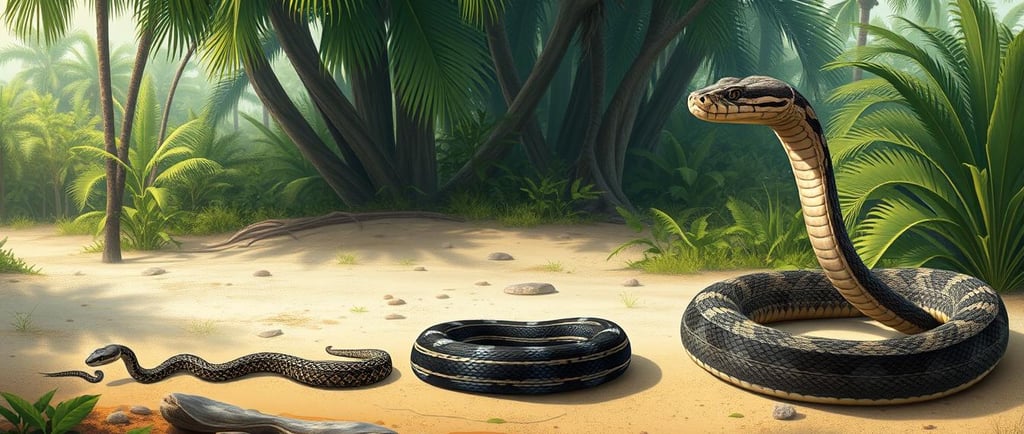Florida Snake's: Your Guide to Florida's Nature Serpents
Florida Snake's: Your Guide to Florida's Nature Serpents. Did you know Florida's human population has grown a lot in the last 30 years? This means more people are likely to meet snakes and legless lizards.
WILDLIFEENVIRONMENTAL SNAKES AND LIZARDS


Florida Snake's: Your Guide to Florida's Nature Serpents
Did you know Florida's human population has grown a lot in the last 30 years? This means more people are likely to meet snakes and legless lizards. This guide talks about 86 species and subspecies of these reptiles in Florida. It includes native, introduced, and established species.
With detailed color photographs, range maps, and insightful descriptions, this field guide is a must-have. It helps you understand Florida's diverse snake population better.
Key Takeaways
This guide covers 86 species and subspecies of snakes and legless lizards in Florida.
Florida's growing population has led to more frequent encounters with these reptiles.
The guide includes detailed information on snake identification, behavior, and habitat.
Florida hosts a wide range of snake species, from the 2-foot green snake to the 6-foot diamond-backed rattlesnake.
The guide is the only one of its kind to cover native, introduced, and commonly seen snake species in Florida.
Understanding Florida's Snake Population
Florida's snake population is diverse and fascinating. The Sunshine State has both native and introduced snakes. Each species has its own unique traits and behaviors.
Native vs. Introduced Species
Florida has always had many native snake species. But, the state now has even more snakes thanks to non-native species. The Burmese python is a famous example of these introduced snakes.
These snakes pose both challenges and opportunities for research and conservation.
Population Distribution Across the State
Snakes live in many habitats in Florida, from the Everglades to scrublands. The distribution of snake species varies. Some, like venomous snakes in florida, are more common in certain areas.
Knowing the florida snake regulations and where different snakes live is important. It helps both snake lovers and those who want to live safely with these reptiles.
Common Size Ranges of Florida Snakes
Snakes in Florida come in all sizes. The tiny Brahminy blind snake and the huge Burmese python are examples. But, most snakes you'll see are 2 to 6 feet long.
These include the green snake, yellow rat snake, and diamond-backed rattlesnake.
By learning about Florida's snake population, we can better appreciate these reptiles. We can also learn how to live safely with them.
Identifying Common Florida Snake Species
Exploring Florida's snakes is exciting for nature lovers. Whether you love the outdoors or just want to learn about local wildlife, knowing the common snakes in Florida is useful. You'll find everything from the famous Eastern Diamondback Rattlesnake to the rare Indigo Snake.
Visual Identification Methods
Looking at a snake's color, pattern, and size is a great way to tell what it is. For example, the Coral Snake has red, yellow, and black bands. The Black Racer, on the other hand, is all dark.
Also, check the snake's head, pupils, and if it has heat-sensing pits. These details help you figure out what kind of snake it is.
Pattern Recognition Guide
Uniform: Black Racers, Green Snakes, Scarlet Snakes
Striped: Coachwhips, Garter Snakes, Ribbon Snakes
Ringed: Coral Snakes, Scarlet Kingsnakes
Diamond/Blotched: Eastern Diamondback Rattlesnake, Timber Rattlesnake, Cottonmouth
Cross-banded: Florida Kingsnake, Corn Snake
Range Maps and Habitat Locations
Knowing where snakes live and what they like can help you identify them. Some snakes, like the Florida Cottonmouth, are everywhere. Others, like the Dusky Pigmy Rattlesnake, are only in certain places.
Looking at range maps and knowing where snakes live can help you spot them in the wild.
By learning about snake colors, patterns, and where they live, you'll get better at identifying them. This knowledge will make your outdoor adventures more fun and help you appreciate Florida's snakes even more.
Florida Snake's: Venomous vs Non-Venomous Species
Exploring Florida's natural landscapes means knowing the difference between venomous and non-venomous snakes. This knowledge keeps you and your loved ones safe, including pets.
In Florida, six venomous snakes are especially dangerous. These include the Harlequin Coralsnake, Eastern Copperhead, and Florida Cottonmouth. Also, the Pygmy Rattlesnake, Timber Rattlesnake, and Eastern Diamond-backed Rattlesnake. Their venom can be very harmful if you get bitten.
Florida also has many non-venomous snakes. Snakes like the Ring-necked snake and Common Gartersnake have weak venom. They use it to catch small prey like centipedes and earthworms. While their bites can cause swelling, they are not a big threat to humans or pets.
Venomous Snakes in Florida Non-Venomous Snakes in Florida Harlequin Coralsnake Ring-necked snake Eastern Copperhead Common Gartersnake Florida Cottonmouth Crowned snake Pygmy Rattlesnake Hog-nosed snake Timber Rattlesnake Eastern Diamond-backed Rattlesnake
Snakes are divided into venomous and non-venomous types in Florida for safety. Venomous snakes can inject more venom, leading to serious health issues. These can include breathing problems, paralysis, and blood clotting issues.
It's important to be careful around all snakes. Knowing the difference between venomous and non-venomous snakes helps you stay safe. This way, you can enjoy Florida's nature while keeping yourself and your loved ones safe.
Snake Habitats and Behavior in Florida's Ecosystem
Florida's varied landscapes are home to many snakes. From the Everglades' wetlands to the Panhandle's dry pine flatwoods, snakes thrive here. Knowing about their habitats and behaviors helps us see their importance in Florida's ecosystem.
Natural Environments
Florida has about 50 native snake species, with seven venomous ones. You can find them in grasslands, forests, swamps, and even cities. Venomous snakes like the eastern diamondback rattlesnake prefer wooded areas. Non-venomous snakes, like the racer, adapt well to both natural and human-altered environments.
Seasonal Activity Patterns
Most snakes in Florida are active in warmer months, especially in spring and summer.
Some, like the Florida pine snake, are active in cooler months. They hunt and bask in milder temperatures.
During extreme temperatures, snakes seek shelter to avoid the heat or cold.
Feeding Habits and Prey Selection
Florida's snakes are meat-eaters, eating rodents, birds, eggs, reptiles, and amphibians. The snake's size and species decide what it can eat. Big snakes, like the eastern indigo snake, eat small mammals. Smaller snakes, like the pygmy rattlesnake, eat insects and lizards.
Snake Species Typical Prey Feeding Frequency Eastern Diamondback Rattlesnake Small mammals, birds, and other snakes Once every 1-2 weeks Corn Snake Rodents, birds, and small reptiles Once every 1-2 weeks Florida Pine Snake Small mammals, eggs, and other snake species Once every 2-4 weeks
Understanding Florida's snakes helps us value their role in the ecosystem. These reptiles keep the environment balanced and healthy. They are crucial to Florida's nature coast.
Snake Safety and Encounter Management
Florida is home to many natural wonders, including its snakes. Encountering a snake might seem scary, but most are harmless. The state has many non-venomous snakes that don't harm humans.
Most snakes in Florida homes are not venomous. But, venomous snakes can also live in homes. If you see a snake, stay away and don't try to touch it. Use humane traps to catch it safely.
Only a small percentage of snakebites result in fatalities, with approximately 5-6 deaths per year in the United States due to venomous snake envenomation.
Roughly 20-30% of victims bitten by venomous snakes may not develop symptoms, highlighting the relatively low risk of serious injury.
If a snakebite does occur, call the Poison Control Centers' National Hotline at 1-800-222-1222 for immediate guidance before the arrival of emergency medical services.
Snakes are important in Florida's ecosystem. They help control rodent populations and eat other venomous snakes. Unless a snake is a danger, it's best to let it be.
If you're worried about a snake on your property, call a wildlife removal expert. Knowing about snakes and how to handle them lets you enjoy Florida's nature safely.
Statistic Value Annual snake-related deaths in the US 5-6 Percentage of venomous snakebite victims who don't develop symptoms 20-30% Percentage of snake-related deaths due to venomous envenomation 10%
Conclusion
Exploring Florida's snake population shows how vital they are to the state's ecosystem. With over 50 species, they come in all shapes and sizes. Each plays a key role in Florida's nature.
Some snakes, like the Eastern Indigo Snake, are safe around humans. But others, like the Florida Cottonmouth, have venom and need care. Knowing the difference helps keep everyone safe and supports snake conservation florida.
The rise of invasive species, like the Burmese Python, is a big threat. We must help protect florida snake species and their homes. By learning about these snakes, we can help keep Florida's nature beautiful for the future.
FAQ
What are the different types of snakes found in Florida?
Florida has a wide variety of snakes, with 86 species and subspecies. This number has grown since the state was more wild. This is because of the introduction of non-native species.
How do I identify different snakes in Florida?
The guide helps you identify Florida snakes through visual identification and pattern recognition. Snakes can be identified by their color or pattern. This can include uniform, stripes, rings, diamonds, crossbands, or blotches.
Each species has a color photograph and a range map. This map shows where they live.
Are there any venomous snakes in Florida?
Yes, the guide tells the difference between venomous and non-venomous snakes in Florida. It gives details on the venomous qualities of each snake. This helps readers understand the risks of different species.
Where can I find snakes in Florida?
The guide talks about where snakes live in Florida. This includes natural environments and urban areas. It also discusses how seasons can affect snake activity.
What should I do if I encounter a snake in Florida?
The guide gives important tips on snake safety and how to handle encounters. It advises on what to do when you see a snake. It stresses the need to respect wildlife and keep a safe distance.
The guide also talks about legal issues with snake handling and removal. It makes sure readers know the right procedures and laws.
How can I contribute to snake conservation in Florida?
The guide's conclusion highlights the need to understand and appreciate Florida's snakes. It encourages readers to help protect these reptiles and their homes.

